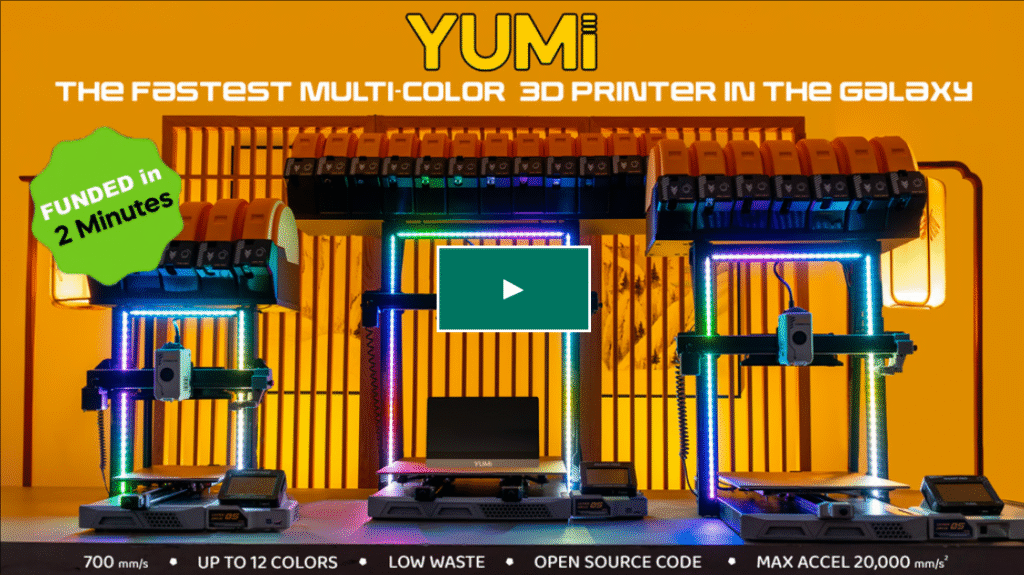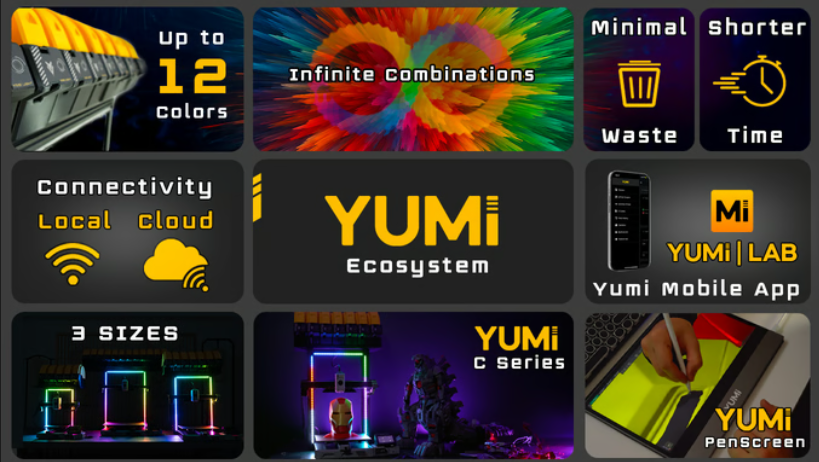Introduction: The YUMI Hype
A new Kickstarter campaign is creating waves in the 3D printing community. Meet YUMI, the self-proclaimed “fastest multicolor printer in the galaxy.” With bold claims and sleek visuals, YUMI is trying to carve out a place in an already competitive market dominated by names like Bambu Lab and Prusa. But does it live up to the hype?

Design & Build Quality
From the Kickstarter visuals, YUMI looks compact and modern, with a clean desktop-friendly footprint. The enclosure appears semi-enclosed, likely helping with temperature consistency. Although exact materials are not disclosed, it gives the impression of a premium consumer-grade device rather than a DIY kit.
Cable routing and extruder positioning seem thoughtfully laid out, but as of now, we don’t have teardown shots or third-party assembly reviews to verify internal quality. It’s a wait-and-see situation, but first impressions are promising.
Multicolor Printing System
This is YUMI’s main selling point: seamless multicolor printing. While not much technical detail has been released yet, it’s clear that the printer supports up to 4 filaments and some form of automated filament switching.
We don’t know yet if YUMI uses an AMS-like system (like Bambu) or a mechanical switcher (like Prusa MMU). What’s interesting is that the marketing focuses on ease-of-use and faster transitions between colors. The success of this feature will hinge on reliability—an area where competitors have stumbled.
Speed & Performance Claims
YUMI markets itself as the “fastest” multicolor 3D printer. However, there are currently no published speed benchmarks or real-world tests. Without layer height, travel speed, and extrusion rate data, it’s hard to verify the claim.
If YUMI manages to deliver multicolor prints at speeds comparable to high-speed single-material printers, it would be a game changer. But until we see test prints and third-party reviews, the speed claim remains aspirational.
Slicer & Software Compatibility
The campaign hasn’t confirmed which slicers YUMI supports. It’s safe to assume compatibility with popular ones like Cura or PrusaSlicer, but whether they provide a proprietary slicer or forked version is unclear.
Software matters greatly in multicolor workflows—color assignment, purge tower optimization, and failure recovery all need robust backend handling. We’ll be keeping an eye on what they reveal next.
Pros and Cons Summary
Pros:
- Promising multicolor functionality
- Compact, attractive design
- Potentially faster than MMU-style systems
- Enthusiastic early community backing
Cons:
- No proven performance data yet
- Unknown slicer/software support
- No real-world demo prints
- Kickstarter delivery timelines always carry risk

Comparisons: YUMI vs Bambu Lab vs Prusa
Compared to Bambu Lab X1C or P1S with AMS, YUMI appears to target a slightly more affordable and compact niche. It may not offer the same build volume or mature ecosystem, but its appeal lies in streamlined multicolor operation.
Against Prusa MK4 + MMU3, YUMI’s main advantage would be speed and simplicity. MMU3 systems often suffer from filament feed failures—if YUMI solves that elegantly, it might convert a lot of skeptics.
However, both Bambu and Prusa have years of firmware development, user community, and tech support. YUMI must prove it can match not just specs, but user experience.
Backer Considerations: Should You Support It?
As with all crowdfunding projects, caveat emptor applies. YUMI is visually appealing and technologically intriguing, but buyers should understand the risks:
- Will the final product match the prototype?
- Can the creators handle mass production?
- Are spare parts and support planned?
We recommend interested users follow the campaign closely and wait for third-party reviews before making a large pledge.
Final Verdict: Worth Watching or Just a Flashy Debut?
YUMI could be the fresh, colorful disruptor that multicolor printing needs—or just another Kickstarter dream. For now, it’s firmly in the “one to watch” category. If the team delivers on their promises, it could become a sleeper hit in 2025’s 3D printing scene.
Stay tuned. We’ll be keeping a close eye on it.